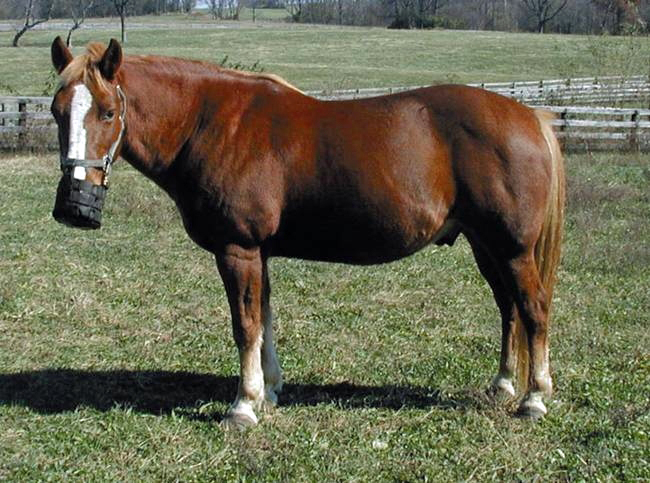
Florida pasture grasses contain lower sugar content than in other parts of the country. Even so, pasture access might need to be limited to help control calorie intake. Limiting grazing time may cause some horses to overeat when they are turned out, so consider using a grazing muzzle or feeding horses some hay before turnout to slow intake. Photo Credit: Amy Parker
Marcelo Wallau, Lori Warren, Carissa Wickens, Jose Dubeux and Doug Mayo, UF/IFAS Extension
As extension specialists, we are often asked about nonstructural carbohydrates (NSC) in forages and the potential risks grazing poses to insulin-resistant horses. Numerous blog posts and reports have been written on the topic, alarming horse owners everywhere. However, for horses managed on pastures in Florida, is over-consumption of NSC actually a problem?
Nonstructural carbohydrates are a form of energy reserve in plants, and include simple sugars, fructan and starch. The major source of NSC in a horse’s diet is usually from grains, which range from 60 to 85% starch, and commercial concentrate feeds, frequently containing molasses and other ingredients to increase palatability. In forages, the concentration of NSC depends on plant type, management, and season of the year, typically highest in the spring and fall when growth is slow and seedheads are present. Temperate climate forages (e.g. orchard, timothy, or our cool-season species here in Florida, such as oats, ryegrass and clovers) tend to have more NSC (around 16%) than our warm summer grasses (around 8%), such as bahiagrass and bermudagrass.
Several factors are known to contribute to the development of metabolic disorders in horses, including genetics (Morgans, Arabians, ponies, and Spanish breeds are most affected), overfeeding (of anything, not just grain), overweight/obese animals (those prone to being “easy keepers”), and lack of exercise. The most common metabolic disorders are Cushing’s Disease (pituitary pars intermedia dysfunction) usually associated with aging, and equine metabolic syndrome (resulting from the genetic and management factors described above). What they share in common is insulin resistance (similar to, but not exactly like Type 2 diabetes in humans), making them susceptible to secondary diseases such as laminitis or founder. These horses tend to be more sensitive to sugar, starch, and fructan in the diet. Not all horses have these problems. In fact, the frequency of laminitis in horses is low, ranging from 2 to 5% (Kane et al., 2000) and normally is related to horses which have a predisposition, either genetic or acquired from sub-optimal management practices.
For horses with metabolic disease or a history of laminitis, feeding diets with less than 10% NSC is recommended. Reducing NSC in the diet can be accomplished by cutting back on grain consumption and any other sort of treat containing high sugar levels. For lush pastures containing cool-season forages, there may be a need for limiting pasture access and timing turnout to occur in the period from late night to early morning when sugar and fructan levels in the grass will be at their lowest. For pastures containing Florida’s warm-season forages, NSC is less of a problem, but pasture access might need to be limited to help control calorie intake. Note that limiting grazing time may cause some horses to overeat when they are turned out, so consider using a grazing muzzle or feeding horses some hay before turnout to slow intake. These approaches combined with monitoring horses’ body condition and weight will allow owners and farm managers to safely utilize forages in feeding horses diagnosed with metabolic disorders.
Although the incidence of insulin-resistance is relatively low, many people worry about the health of their horses housed on pasture. What is important, however, is to provide a balanced diet which is in accordance with the category and use of the animal: growing, lactating and active horses (working or athlete) need a more nutrient dense diet to meet their requirements, while most leisure horses’ nutrient requirements can be met primarily by forages and a vitamin-mineral supplement. Nevertheless, the low NSC content of most forages in Florida represent a low risk, even for horses with pre-disposition for metabolic disorders
The following are some additional references and suggestions for further reading on this topic:
- Kronfeld DS, Harris PA. 2003. Equine grain-associated disorders (EGAD). Compendium on continuing education for the practising veterinarian. 25:974–83.
- Lameness and laminitis in U.S. horses. 2000. USDA: APHIS: VA, CEAH, National Animal Health Monitoring System. Fort Collins,CO. Contract No.:N318.0400.
- Kane AJ, Traub-Dargatz J, Losinger WC, Garber LP. 2000. The occurrence and causes of lameness and laminitis in the U.S. horse population. San Antonio TX: Proceedings of the 46th AAEP; Nov 26–29; p.277–280.
- Longland, A.C., and B.M. Byrd. 2006. Pasture Nonstructural Carbohydrates and Equine Laminitis. J. Nutr. 136(7): 2099S–2102S
- Wickens, C. 2016. Monitoring Body Condition in Horses: Helpful Smart Phone Apps for Horse Owners.
- UF/IFAS 2025 Top Rancher Challenge Showcases Youth and Adult Talent - July 11, 2025
- Cow Talks: Special Guests Discuss the Impact of H5N1 Avian Influenza on Agriculture - April 25, 2025
- Why is this weed here? Weed Management in Pasture Systems - February 28, 2025
